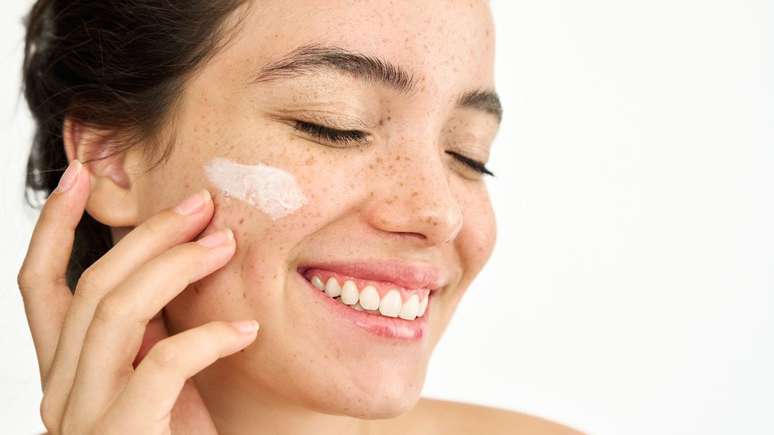Daily care helps preserve the beauty and health of the skin, reducing imperfections and facial expression lines
Keeping facial skin young and healthy is the desire of many people. In addition to wrinkles and sagging, which tend to appear at an advanced age, imperfections and scars can also appear at a young age. All these changes can damage the way the patient sees their own beauty. The good news is that there are several strategies that help preserve the beauty of your skin.. Below you will find seven expert tips for keeping your facial skin young.
Use sunscreen every day
Using sunscreen is essential to keeping your skin young and healthy. “The daily use of sunscreen is essential to prevent skin cancer, but also to keep the skin young, firm and elastic. Sunscreen is the great defender of the effect of radiation on the destruction of collagen”, advises the dermatologist Claudia Marçal, member of the Brazilian Society of Dermatology (SBD).
The doctor explains that long ultraviolet A radiation reaches the deep dermis, where the melanin-producing cells (melanocytes) are located, causing a process of breakdown of the collagen fibres. According to her, sunscreen with an SPF of at least 30 is irreplaceable in preventing this damage.
“Even in winter and indoors, the use of sunscreen is essential. Ultraviolet radiation passes through glass and thin fabrics (curtains) and can reach the skin in the same way,” adds dermatologist Paola Pomerantzeff, member of the Brazilian Society of Dermatology.
Follow a skin care routine
According to dermatologist Danilo S. Talarico, specializing in Clinical-Surgical Dermatology and Aesthetic Medicine, starting a skincare routine that includes cleansing, hydration and sun protection is the basis for keeping skin young. “Use products that contain hydrating ingredients, such as hyaluronic acid, alpha-hydroxy acid, and botanical oils. With guidance, add products that contain anti-aging ingredients, such as retinol, glycolic acid, and peptides, to your routine, and don’t forget to take oral supplements recommended by the doctor”, guides.
According to dermatologist Claudia Marçal, the introduction of antioxidants is also welcome. “Actives for this purpose can be present in moisturizers, in formulas with vitamins C and E, ferulic acid, resveratrol and alistine, which are classic active ingredients,” he explains.
To make skin care even more sophisticated, there are technologies that promote in-office skin care, such as HydraFacial, which combines skin cleansing with the application of powerful boosters. “HydraFacial improves the quality of the skin’s surface, since its tips are equipped with an exclusive technology capable of generating a vortex that extracts impurities by infusing active ingredients into the skin. Therefore, the procedure cleans, revitalizes, hydrates and purifies the skin tissue “, says dermatologist Renato Soriani, former coordinator of the Department of Laser and Technologies of the Brazilian Society of Dermatology.
Take care of your neck too
The skin of the neck also requires particular attention and care in the daily routine. This is because the region is thinner, with little subcutaneous tissue and very close to the deeper muscle layers. This causes aging changes such as sagging, static wrinkles and tighter muscles. Furthermore, contractions of the neck muscles can also damage the contour of the face.
“Few know, but the neck muscle, called platysma, is a depressor of the face, that is, its continuous contractions tend to ‘pull’ the entire region of the lower third downwards. To avoid this type of situation, facial treatments it should be extended to this area. I always warn patients about the importance of using botulinum toxin on the face and also on the neck”, explains dermatologist Claudia Merlo.
Lip care
In addition to being a cancer-prone region, the skin on the lips also ages. This aging begins around age 30 and is progressive. “It occurs due to the intrinsic aging process of the face: a loss of collagen occurs with a decrease in skin firmness and a decrease in facial fat. In addition, we use the muscles around the mouth a lot (chewing and facial expression – smiling and speaking)”, explains dermatologist Paola Pomerantzeff.
“Signs of aging in the region include loss of volume and wrinkles known as ‘barcodes’. “Lips become thinner, with wrinkles around the mouth, the famous ‘barcode’, and resulting loss from the corner of the mouth or ‘sad smile,’ says the doctor. The main preventive care should be hydration and sun protection.
“Sun protection for the lips is extremely important. I see that even today the population does not realize its importance, but it is very important due to the exposure we have on the lips, especially in the lower part, and especially in people who have full lips, or people who end up having a more fragile mucosa, or who have a tendency to touch their lips, passing their tongue over it. This is an area that ends up becoming too sensitized, so it is very susceptible to skin cancer.” , explains . dermatologist Mônica Aribi, full member of the Brazilian Society of Dermatology.
Avoid touching your face with your hands
Every time you touch your face, you transfer dirt, germs, and oil from your hands to the skin in the area. Do your best to leave your skin alone throughout the day. Touching your face can spread dirt, oil and bacteria, which can clog your pores.
“Your hands come into contact with so many things every day – doorknobs, greasy phone screens, etc. – and this transfer of bacteria can easily soil your skin, causing clogged pores and inflammation. This explains why, even in the cold and without excessive oil production, there is still acne,” says dermatologist Abdo Salomão Jr., a member of the Brazilian Society of Dermatology.
Viruses and potentially pathogenic microorganisms can remain in hair, beard, clothing or objects. “This is why it is also essential to wash your hands often and avoid touching your face”, adds dermatologist Paola Pomerantzeff.
Check your skin regularly
Skin cancer is the most common type of cancer. However, if diagnosed early, skin cancer – including melanoma – is highly treatable. It is important to check your skin regularly for new spots, spots that are different from other spots on your body, or spots that itch, bleed, or change color, as these are often the first signs of skin cancer.
“Typically, these suspicious lesions are characterized by wounds that do not heal or by ‘nevi’ that increase in size, change color, hurt, or itch. Lesions in nevi must also obey the ABCD rule, i.e. they cannot be asymmetrical (A ), they cannot have irregular edges (B), nor be of a different color (C) nor have a diameter (D) greater than 1 cm, consult a doctor immediately”, adds dermatologist Mônica Aribi. .
Preventive care for young skin
Through injectable, laser, radiofrequency, or ultrasound procedures, preventative treatments can help create “collagen sparing,” which keeps skin looking younger for longer. “There are several innovations that help in this process, with particular attention to the Atria microfocused ultrasound and the Quadri Pico, Vektra Pico and Pico Ultra 300 picosecond lasers. These technologies stimulate collagen production and do not distract the patient from daily activities “, explains dermatologist Abdo Salomão Jr.
Plus, there are treatments like high-performance radiofrequency microneedling. “It works by remodeling collagen. In the procedure, the microneedles ‘puncture’ the surface tissue of the skin and release radiofrequency into the deeper layers, helping to stimulate collagen,” explains dermatologist Renato Soriani.
“During the session we can also perform injections of a collagen biostimulator, which is applied to stimulate the fibroblasts to produce collagen. This combination guarantees an even better result in the treatment of wrinkles and sagging”, concludes dermatologist Cláudia Merlo.
Source: Terra
Ben Stock is a lifestyle journalist and author at Gossipify. He writes about topics such as health, wellness, travel, food and home decor. He provides practical advice and inspiration to improve well-being, keeps readers up to date with latest lifestyle news and trends, known for his engaging writing style, in-depth analysis and unique perspectives.









